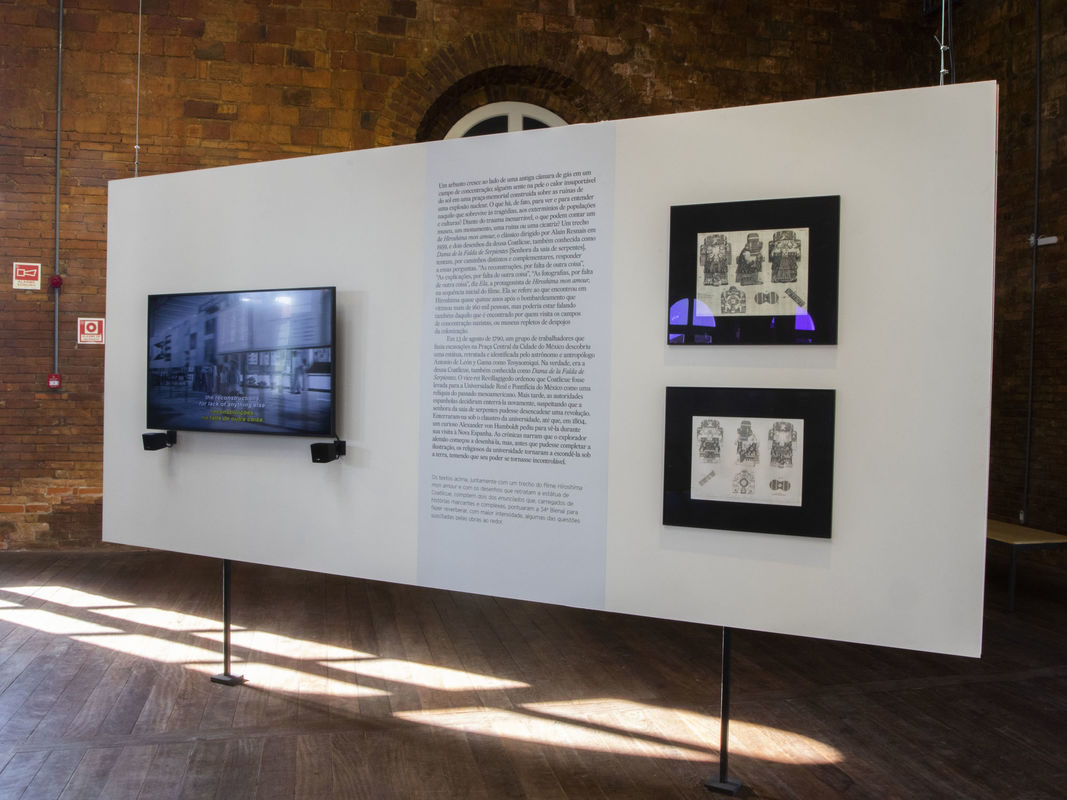The traveling exhibitions program of the 34th Bienal de São Paulo – Though it’s dark, still I sing arrives in the Northern region of Brazil for the first time. The exhibition takes place in Belém, at the Solar da Beira and the City Market, both located in the Complexo Ver-o-Peso, from September 29 until November 20. It was enabled by the cultural support of CODEM – Companhia de Desenvolvimento da Área Metropolitana [Metropolitan Area Development Company], Belém City Hall, as well as SECON – Secretaria Municipal de Economia [City Economy Secretariat] and FUMBEL – Fundação Cultural do Município de Belém.
The exhibition is organized around two statements, The Engraved Image of Coatlicue and Hiroshima mon amour by Alain Resnais, reverberating, with greater intensity, some of the issues raised by the artworks, such as otherness and opacity – the latter is a concept of Édouard Glissant, one of the theoretical references of the 34th Bienal.
The exhibition is composed of works by nine artists from eight different countries: Alice Shintani (Brazil), Claude Cahun (France), Gala Porras-Kim (Colombia), Haris Epaminonda (Cyprus), Jungjin Lee (South Korea), Marinella Senatore (Italy), Melvin Moti (Netherlands), Naomi Rincón Gallardo (United States) and Uýra (Brazil).
In the Ver-o-Peso Market, the public can see the light sculpture Nos erguemos ao levantar outras pessoas [We Rise by Lifting Others] (2021), a work specially made for the 34th Bienal de São Paulo. The 10 meter installation hangs over the passersby, close to the market ceiling, creating an ephemeral and stunning architecture. Formed by dozens of lamps, the work reminds us of the strength of actions carried out collectively.
On The Engraved Image of Coatlicue statement
On August 13, 1790, a group of workers excavating in Mexico City’s Central Plaza discovered a statue the astronomer and anthropologist Antonio de León y Gama identified as Teoyaomiqui. It was, in fact, the goddess Coatlicue, also known as Dama de la Falda de Serpientes (The Lady in the Snake Skirt). In the Aztec mythology, Coatlicue is the patroness of life and death. She is the mother of Huitzilopochtli, god of earth, and represents fertility. Coatlicue’s statue was taken to the The Royal and Pontifical University of Mexico as a relic of the Meso-American past. But after long discussions, the Spanish authorities decided to bury it again in order to prevent the Lady in the Snake Skirt from initiating a revolution. In 1804, a curious Alexander von Humboldt asked to see it during his trip to New Spain. According to the legend, the German explorer began to draw it without, however, completing the illustration because the university clergymen, perhaps fearing that Coatlicue’s power would become uncontrollable, hid it again underground. Hence, Humboldt had to let his imagination run wild to immortalize Coatlicue’s powerful aura in his sketches.
On the statement Hiroshima mon amour by Alain Resnais
In light of an unspeakable trauma, what can be told by a museum, a monument, a ruin or a scar? “The reconstructions, for lack of anything else,” “the explanations, for lack of anything else,” “the photographs, for lack of anything else,” says the (French) protagonist of Hiroshima mon amour, Elle, in the opening scene of the classic film directed by Alain Resnais in 1959. Elle is referring to what she found in Hiroshima nearly fifteen years after the bombing that killed more than 160 thousand people, but could also be talking about what would be found by anyone who visits the ruins of Nazi concentration camps, or even the museums full of the plunder of colonization. The objects, the photographs, the explanations, the reconstructions are not enough for us to understand. Hiroshima mon amour does not seek to explain nor to reconstruct, but rather to probe the opacity and untranslatability of what has remained as a witness of tragedy.
Service
34ª Bienal de São Paulo – Though it's dark, still I sing
Traveling exhibitions program
Solar da Beira
Belém (PA)
September 29 – November 20, 2022
Boulevard Castilhos França, 120
Tuesday – Friday, 8am – 5pm
Saturday and Sunday, 8am – 2pm
free entrance
Mercado Ver-o-Peso
Belém (PA)
September 29 – November 20, 2022
Boulevard Castilhos França
Monday – Thursday, 6am – 1pm
Friday – Saturday, 6am – 1:30pm
Sunday, 6am – 12pm
free entrance
![Obra de [Artwork by] Marinella Senatore, Mercado Ver-o-Peso em [in] Belém. © Oswaldo Forte / Fundação Bienal de São Paulo](http://imgs.fbsp.org.br/files/2f337e0ba5097ffabdd9a9e13c5618d9.jpg)

![Obras de [Works of] Jungjin Lee no [at the] Solar da Beira © Oswaldo Forte / Fundação Bienal de São Paulo](http://imgs.fbsp.org.br/files/dba1de9c4db292f4c3e16a6f8bbdf1f1.jpg)
![Obras de [Works of] Uýra no [at the] Solar da Beira © Oswaldo Forte / Fundação Bienal de São Paulo](http://imgs.fbsp.org.br/files/66b86998f9bddc33398aae5a006c58f1.jpg)
![Obra de [Work of] Gala Porras-Kim no [at the] Solar da Beira © Oswaldo Forte / Fundação Bienal de São Paulo](http://imgs.fbsp.org.br/files/eea5b885656e7bd9d97380fac263decc.jpg)
![Obra de [Work of] Melvin Moti no [at the] Solar da Beira © Oswaldo Forte / Fundação Bienal de São Paulo](http://imgs.fbsp.org.br/files/0b78b8254d27b1cf1567d7d7e838475c.jpg)
![Obras de [Works of] Claude Cahun no [at the] Solar da Beira. © Oswaldo Forte / Fundação Bienal de São Paulo](http://imgs.fbsp.org.br/files/8e001b448ec22c7096d4b4efe835e811.jpg)
![Obras de [Works of] Haris Epaminonda no [at the] Solar da Beira © Oswaldo Forte / Fundação Bienal de São Paulo](http://imgs.fbsp.org.br/files/e4c9cd90ee7b829ba0db307daf0774c9.jpg)
![Obra de [Work of] Haris Epaminonda no [at the] Solar da Beira © Oswaldo Forte / Fundação Bienal de São Paulo](http://imgs.fbsp.org.br/files/c2c2df7d8a88a4fb00098426c3768677.jpg)
![Obras de [Works of] Alice Shintani no [at the] Solar da Beira © Oswaldo Forte / Fundação Bienal de São Paulo](http://imgs.fbsp.org.br/files/9fc5ff0ee40c118e7e253439be714099.jpg)
![Obra de [Work of] Naomi Rincón Gallardo no [at the] Solar da Beira © Oswaldo Forte / Fundação Bienal de São Paulo](http://imgs.fbsp.org.br/files/3f856016c8d65db260bf6174fc9a7445.jpg)
![Sinalização da exposição no [exhibition signage at the] Solar da Beira © Oswaldo Forte / Fundação Bienal de São Paulo](http://imgs.fbsp.org.br/files/ebbab03c0d41ca98c6276c0bcdee9ca8.jpg)

